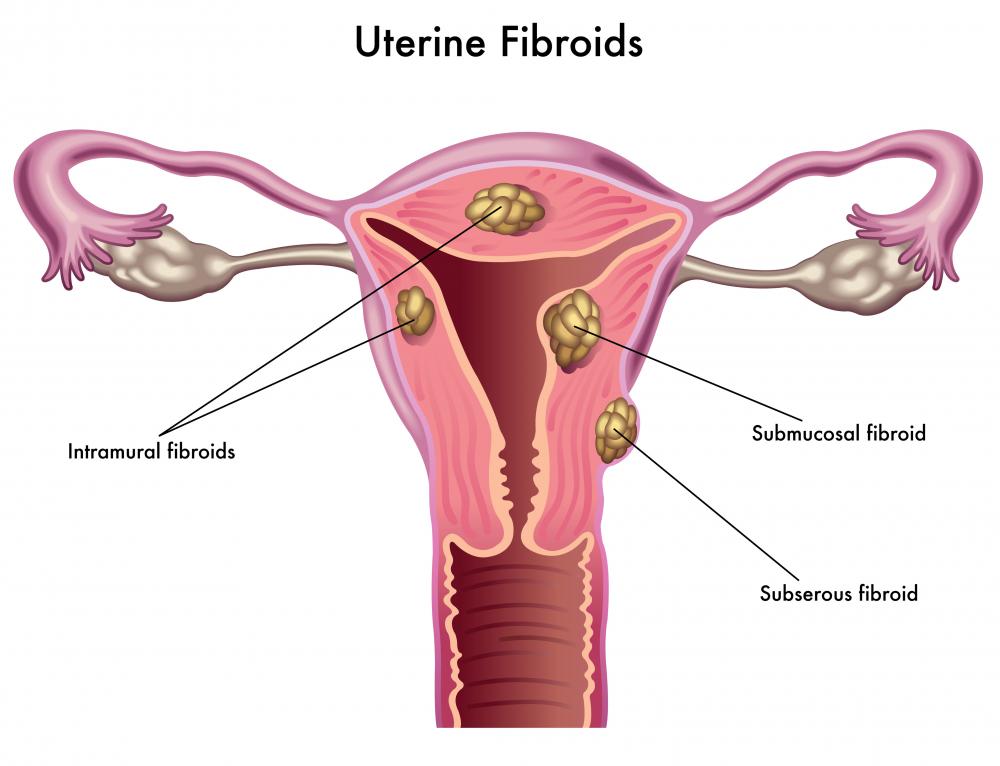At WiseGEEK, we're committed to delivering accurate, trustworthy information. Our expert-authored content is rigorously fact-checked and sourced from credible authorities. Discover how we uphold the highest standards in providing you with reliable knowledge.
What is an Intramural Fibroid?
Uterine fibroids are noncancerous or benign uterine growths that develop within or outside the reproductive organ. The exact cause of fibroid tumors remains unidentified, although, it is believed that estrogen significantly contributes to their growth. Fibroids appear in several different types. The various names are assigned according to the location of the abnormal growths in the uterus. An intramural fibroid is a type of fibroid that grows inside a woman's uterine wall.
An intramural fibroid is one of the most common types of fibroids. Although, they can occur in women of any age, they typically develop in women who have begun to menstruate, but who have not yet reached menopause. Many women with fibroids are asymptomatic and show no exact symptoms. In many cases, a routine pelvic examination will lead to their discovery. For women who experience symptoms, they can range from being mild to very severe.

Due to the fact that an intramural fibroid grows within the uterus, a woman may face great discomfort as the fibroid expands. While many fibroids remain very small, some can grow rather large and push onto adjacent organs in the pelvis. Some common fibroid symptoms include pelvic pain, abdominal bloating, abnormal menstrual bleeding and constipation. A large fibroid may cause leg pain, frequent urination and pelvic pressure. Generally, different women endure different fibroid symptoms.

After conducting a complete pelvic examination, a doctor may order additional tests to diagnose an intramural fibroid. This is important because the pelvic mass or lump could indicate other health conditions, such as an ovarian cyst or inflammation. Commonly, a doctor will order diagnostic tests such as an ultrasound or a computerized tomography (CT) scan. There may also be a uterine biopsy or a hysteroscopy. During a hysteroscopy, saline is injected into the uterus and a telescope is used to thoroughly examine the organ.

Typically, women without significant symptoms will need no intramural fibroid treatment. Women with mild symptoms may be given prescription pain medications. For individuals with severe symptoms, fibroid surgery may be necessary. The type of surgery a woman receives may depend on the size of the fibroid, most problematic symptoms and the woman's desire to have children. Surgery options may involve removing just the fibroids in a myomectomy or the entire uterus in a hysterectomy.
If a woman suspects that she may have an intramural fibroid, she should seek medical attention as soon as possible. A physician can perform the necessary tests to correctly identify the condition. Symptoms of a uterine fibroid can be closely related to other reproductive conditions. Some of these conditions can be malignant or cancerous in nature. For this reason, it is important to have abnormal symptoms investigated as soon as they appear.
AS FEATURED ON:
AS FEATURED ON:













Discussion Comments
Fibroid embolization is a procedure in which doctors cut off the blood supply to the fibroids, essentially killing them. A catheter is used to insert the clotting agents, stopping the flow of blood to the fibroids. Once the blood supply is cut off, the fibroids begin to shrink and eventually they die.
Post your comments